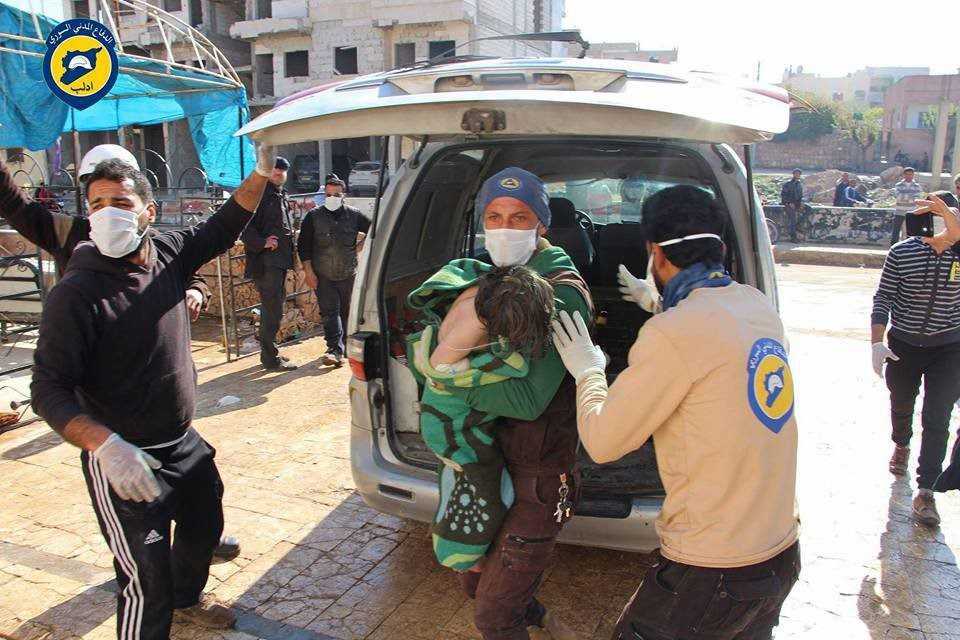At least 50 killed, hundreds injured in Idlib ‘gas attack’ as rescuers say they cannot keep up
AMMAN: A suspected regime gas attack killed at least 50 […]
4 April 2017
AMMAN: A suspected regime gas attack killed at least 50 people and injured hundreds more in Syria’s northwest Idlib province on Tuesday, four sources on the ground told Syria Direct.
At 6:30 Tuesday morning, warplanes thought to belong to the Syrian regime carried out “four strikes of missiles loaded with poison gas” in the town of Khan Sheikhoun, Abu Khaled, a member of the Civil Defense told Syria Direct.
Abu Khaled responded to the scene of the strikes, which he said was a residential area of the rebel-held town, which lies roughly 55km south of the provincial capital of Idlib city.
Towns in rebel-held Idlib province and the adjacent north Hama province countryside are regularly bombed by both regime and Russian warplanes. In recent weeks, the pace of strikes has intensified during a military offensive led by hardline Islamist rebels north of Hama city.
Syrian state media did not immediately report airstrikes in Khan Sheikhoun on Tuesday. The Russian Defense Ministry denied that any of its planes carried out strikes in the area of the town.
“The bombing began while we were sleeping,” Abdullah Najam, a 29-year-old civilian resident of Khan Sheikhoun told Syria Direct on Tuesday. “At first, we didn’t realize that it was poison gas. Then the symptoms started to appear and the Civil Defense came and told us what was happening.”
Videos and pictures from Khan Sheikhoun on Tuesday morning show men, women and children lying on the ground as Civil Defense personnel wearing masks spray them down with water. Some people gasp for air, others appear to have died. Several pictures show the pale, near-naked bodies of young children piled in the back of a truck.
By 4pm on Tuesday, health authorities in the rebel-held province had documented “more than 50 people killed and 300 injured,” Mundher al-Khalil, the head of the Idlib Health Directorate, said on Tuesday in a video press conference. Some opposition sources put the number higher, claiming as many as 100 people killed and 500 injured.
Al-Khalil said the substance released during Tuesday’s airstrikes was “thought to be chlorine and sarin gas.”

Syrian regime forces have repeatedly used chlorine gas against civilian areas in Syria throughout the war, according to human rights monitors and the United Nations. Rebels have also reportedly used it, to a lesser extent. As a choking agent, chlorine gas in large quantities can cause a buildup of fluid in the lungs and possibly death.
As recently as Monday, airstrikes wielding chlorine gas were reported in two towns near Khan Sheikhoun: Latamnah and Hbeit. Late last month, another reported chlorine gas attack hit the Latamnah hospital, killing and injuring medical staff.
Sarin, an internationally banned nerve agent and the substance used in the 2013 Ghouta chemical attacks near Damascus, is colorless, odorless and heavier than air. When inhaled or absorbed through the skin, it blocks nerve cell transmissions, causing symptoms including narrow pupils, confusion, paralysis, respiratory failure and death.
Following the 2013 chemical attacks against rebel-held suburbs near the Syrian capital, the Assad regime signed the Chemical Weapons Convention (CWC) and agreed to destroy its stockpiled chemical weapons. The last such weapons were sent out of the country in June 2014, and their destruction formally completed in January 2016.
France’s Foreign Minister Jean-Marc Ayrault called for an emergency meeting of the UN Security Council on Tuesday in response to the reported attack.
Images from Khan Sheikhoun and nearby medical facilities show reported victims of Tuesday’s attack with white and yellow foam coming out of their mouths, and narrowed pupils.
Medical personnel in the town told Syria Direct that patients were coming in with bronchospasms, respiratory failure, low blood pressure, slowed heart rates and pupils narrowed to pinpoints.
“The symptoms don’t point to chlorine, but we can’t confirm it was sarin,” Doctor Okbah a-Dagheem, a doctor in Khan Sheikhoun told Syria Direct on Tuesday. “To do so would require laboratories and modern techniques.”
A large number of those injured and killed in Tuesday’s attack were children, Dr. Mohammad Mansour, the head of the Khan Sheikhoun Hospital, told Syria Direct. “Their resistance to the gas is weak because of their young age,” he said.

Mansour told Syria Direct that a number of patients thought to be killed in the attack had later been revived in the hospital. As a result, residents were told to not immediately bury the dead.
Throughout the day on Tuesday, Civil Defense personnel rushed to transport injured people from Khan Sheikhoun to nearby hospitals and—for the worst cases—the Turkish border.
At the same time, warplanes reportedly struck the Civil Defense headquarters and multiple medical facilities in Khan Sheikhoun with conventional missiles, putting them out of service.
“The situation is really bad,” rescuer Abu Khaled told Syria Direct. “We’re under a lot of pressure. There are so many cases. We can’t rescue this number of people.”
The hospitals and medical facilities that could have taken on patients from Tuesday’s attack were out of service or working at limited capacity after being bombed in recent weeks.
The Maarat a-Numan National Hospital, 23 km north of Khan Sheikhoun, was hit by three alleged Russian airstrikes on Sunday, Syria Direct reported, destroying equipment, injuring people and forcing it to shut down.

Idlib Health Directorate head al-Khalil said the “shortage of materials necessary to treat these injuries” was a major challenge in responding to Tuesday’s attack. Turkey’s state media reported that the country sent 30 ambulances into Idlib province following the bombing, which it said was a chlorine gas attack.
Tuesday’s attack spread fear and panic among residents of Khan Sheikhoun who were not injured, causing most to flee to neighboring towns, resident Najam said.
“People are in a state of chaos and confusion,” he added. “They don’t know how to deal with the gas.”







